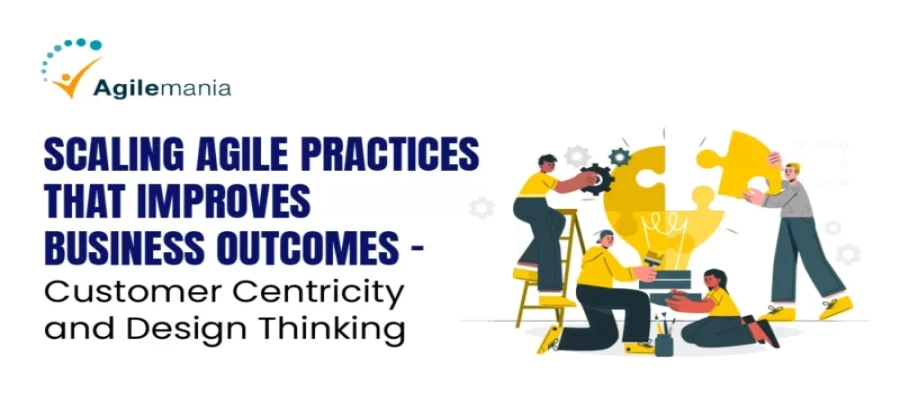
Ashwinee Kalkura
He is SAFe® Premier Trainer, SAFe® SPCT, AHRA (Agile HR Enabler), and an experienced Agile Coach,... Read more

He is SAFe® Premier Trainer, SAFe® SPCT, AHRA (Agile HR Enabler), and an experienced Agile Coach,... Read more

Scaled Agile Framework, SAFe® is the world's leading framework for Business Agility. SAFe® is built around seven core competencies, with customers as a focal point.
The seven core competencies each have three dimensions, for a total of twenty-one dimensions to enable Business Agility. These dimensions contain some of the practices, patterns, and guidelines for Scaling Agility across the enterprise.
One of the dimensions of Agile Product Delivery is Customer Centricity and Design Thinking.
Customer centricity is a mindset and way of doing business that focuses on creating positive engagements as customers experience the products and services the enterprise offers.
Customer-centric businesses create greater profits, increase employee engagement, and more thoroughly satisfy customer needs.
Customer-centric governments and non-profits create resilience, sustainability, and the alignment needed to fulfill their mission.
Lean-Agile Enterprises accomplishes these goals by applying Design Thinking, an iterative solution development process that ensures solutions are desired by customers and users while also ensuring the solution is feasible, economically viable, and sustainable throughout its lifecycle.
Customers are the ultimate beneficiaries of the value of the business solutions created and maintained by the portfolio value streams.
Customer centricity is a mindset and a way of doing business that focuses on creating positive experiences for the customer through the full set of products and services that the enterprise offers.
Customer centricity is a mindset: Whenever a customer-centric enterprise makes a decision, it deeply considers the effect it will have on its end users. This motivates us to:
Design thinking represents a profoundly different approach to product and solution development, in which divergent and convergent techniques are applied to understand a problem, design a solution, and deliver that solution to the market.
Design thinking also inspires new ways to measure the success of our efforts:
The core processes of design thinking appear visually as a ‘double diamond.’
This represents the focus on thoroughly exploring the problem space before creating solutions.
The activities associated with exploring the problem are elaborated as follows: Discover – The discovery phase seeks to understand the problem by engaging in market and user research to identify unmet needs.
The inquiries associated with the discovery phase occur without preconceived notions about how users should work. Instead, it focuses on how users do work.
Define – The define phase focuses on the information gathered during the discover phase, using convergent techniques to generate insights into specific problems and/or unmet needs.
With a clear understanding of the target market and the problems it’s facing, the enterprise can move towards designing a solution, the second diamond of design thinking. These are:
Develop – The development phase uses journey mapping, story mapping, and prototyping to design potential solutions to problems quickly and cost-effectively.
Deliver – The deliver phase produces artifacts that are suitable for creating the solution and vary based on context.
They often start as prototypes. Note that each diamond focuses on divergent thinking (understanding, and exploring options) followed by convergent thinking (evaluating options and making choices).
Customer-centricity scaled Agile enhances customer satisfaction, boosts employee morale, and increases profitability. It ensures products meet customer needs, leading to better market competitiveness and sustained growth. This approach fosters collaboration, adaptability, and innovation, improving customer experiences and overall business success.
By placing emphasis on the customer and remaining flexible to evolving demands, both Agile methodologies and customer-centric approaches can result in quicker development processes and improved results. This enables businesses to maintain a competitive edge and provide offerings that effectively address customer requirements.
He is SAFe® Premier Trainer, SAFe® SPCT, AHRA (Agile HR Enabler), and an experienced Agile Coach, Consultant, and passionate Trainer (SAFe®, IC Agile, and Axelos Accredited) with a demonstrated history of working in the Retail, Mobile, Industrial Automation, Banking, and Networking industries. Strong engineering professional skilled in Agile Methodologies (SAFe®, Scrum, XP, Kanban), Technical Practices, Test Automation, and Stakeholder Management. Trained over 2000 people on Certification-based training.
WhatsApp Us


Great experience with Sumeet. Learning with real life examples helped me understand the basic concepts. Most recommended...

I have taken scrum master training in this company and they are wonderful. i got the best training ever. I am amazed wit...

Sumeet's pedagogy to teach scrum and product management/Product ownership is excellent. We had an interactive session fo...

I recently attended the PSM-I (Professional Scrum Master - Level 1) session conducted by Preeth Pandalay, and it was an ...

Attended the PSM 1 training by Preeth Pandalay. It was an eye-opener in many ways than one. The belief systems we worked...

We will get back to you soon!
For a detailed enquiry, please write to us at connect@agilemania.com
We will get back to you soon!
For a detailed enquiry, please write to us at connect@agilemania.com



